#salmon egg slime mold
Text
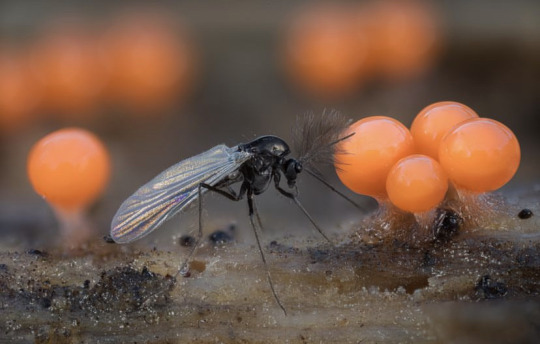
midge resting amongst Trichia decipiens
by Jeremy Lintott
#bugs#slime mold#myxomycota#jeremy lintott#trichia decipiens#trichia#salmon egg slime mold#slime mould#macro photography#microbiology#ecology#microorganisms#microbiota#myxomycetes#insects#forest floor
606 notes
·
View notes
Text

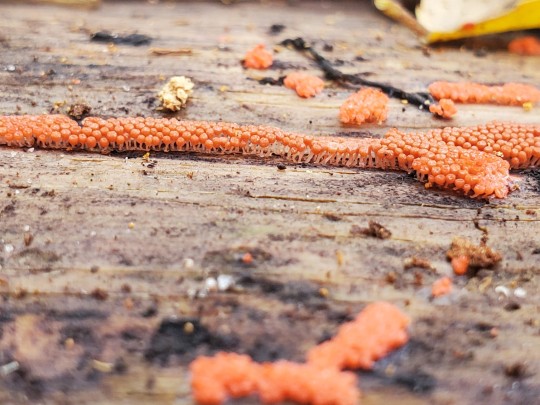
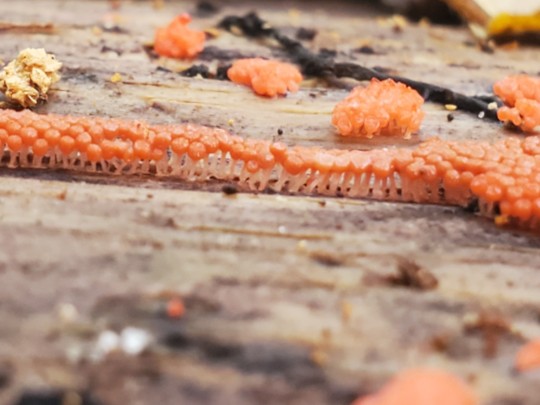


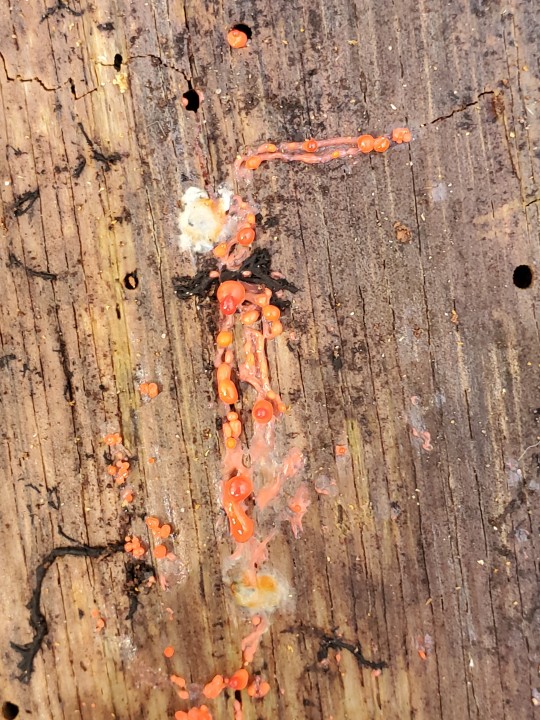
!!!!! Salmon eggs!!! 》 Trichia decipiens
AAAHHHHH. MY FIRST TRICHIA.
Sorry for yelling, I just. This is my second consecutive first ID of a highly anticipated genus! Yesterday I found my first bird nest fungus and now! My first trichia slime mold!! I am a very happy camper. :') ❤️
Regretably, I did not have my DSLR with me on this excursion, but if I have the time I may return with it tomorrow. Just look at that lovely color! 😭🙏
Southeast Texas, 5 Dec. 2023
#amatuer mycology#mushroom hunting#mushrooms#mycology#wild fungi#fungi#mushrooms of texas#texas mushrooms#fungi of texas#fungarium#foraging#species identification#special interest#slime mold#slime mould#trichia#salmon egg slime mold#myxomycota#myxomycetes
77 notes
·
View notes
Text


Tiny acrylic slime mold painting on 1x1.5 inch wood panel. Used this photo I took as reference 🎈
✧ my links ✧
#slime mold#fungi#trichia#salmon eggs#acrylic#painting#wood panel#tiny#mini#art#nature#illustration#macro#mycology#myxomycetes#my art#my photography#bonlynx
72 notes
·
View notes
Text

SLIME!!!!! MOLD
1 note
·
View note
Text


“salmon egg” slime mold Hemitrichia decipiens
265 notes
·
View notes
Text

Salmon egg slime molds
#mushroom#fungi#fungus#mushrooms#artists on tumblr#nature#original photographers#original photography#photography#photographers on tumblr#Washington#pacific northwest#forest#cottagecore#explore#p
139 notes
·
View notes
Text
Nobody asked for it. No one wants it. It's here anyway. LOK Characters as Slime Molds, Part 1:


Korra: The Blob (Physarum polycephalum). Sorry to other slime molds but this one is special. There's nothing else like it. It can solve mazes, appears to sense and anticipate external stimuli, and is the fastest microorganism on the planet. Break it up into pieces and it will stitch itself back together again.


Asami: Salmon Eggs (Trichia decipiens). So shiny and beautiful and eye-catching on a surface level that it's easy to forget this guy is hard at work breaking down dead wood to regenerate the soil. The forest just wouldn't function without it!!


Mako: Wolf's Milk (Lycogala epidendrum). I see this literally every time I'm out in the woods in the summer, like it's always fucking there. Changes color as it ages and goes from a flashy pink to a chill gray/brown. The "I've got your back and I always will" of slime molds.


Bolin: Chocolate Tube (Stemonitis splendens). This slime mold does not like to be alone, and is usually found in dense clumps. The camera loves it because it's fun and vivacious and makes you say "hey what's that" when you see it on a rotting stump.


Raiko: Dog Vomit (Fuligo septica). No explanation needed.
108 notes
·
View notes
Photo

Slime Mold ( trichia decipiens )
Top 9 Secret Facts About Slime Molds:
Once thought to be in the same groups as mushrooms (fungi), now they are classified as a type of amoeba (single-celled organism).
There are over 900 species.
They are most commonly found in lawns, soil, floors of forests, and even on rotting logs. In tropical areas they will be found on fruits and tree canopies. In cities, slime mold can be located in leaf mold, mulches, gutters, and inside air conditioners, especially those that may have blocked drainage.
Don’t worry, slime molds are harmless. They prefer feasting on bacteria from decaying leaves rather than your brain. However, if you have allergies, the spores may cause some sneezing.
Some slime molds take odd shapes and have names that match- like ‘dog vomit’ and ‘bird poop.’
Slime molds reproduce by releasing their version of seeds, called spores.
When you see slime mold in your yard or on a tree trunk, it’s really lots of slime molds coming together, like a transformer or a lego ship.
Most slime molds spend their days alone and unseen (microscopic). However, when food gets scarce, they slowly move towards one another to create a new structure to produce spores that will be taken to a new place by the wind.
Although they do not have brains, researchers have found that they have the ability to ‘learn’ and go through mazes.
#slime mold#slime mould#trichia decipiens#trichiidae#saprotrophic#eggs of salmon#wildlife photography
31 notes
·
View notes
Text
New Post has been published on Everybody Eats News
New Post has been published on https://everybodyeatsnews.com/2020/03/how-to-stock-your-pantry-while-staying-at-home/
How To Stock Your Pantry while Staying at Home
These Are the Best Foods to Stockpile for a Possible Quarantine
We asked experts to tell us what groceries deserve a spot in our fridge, freezer, and pantry come what may.
By Stacey Ballis for All Recipes
The coronavirus disease (COVID-19) is officially a pandemic, and depending on where you live, you are either close to some burgeoning centers of disease or are anticipating cases emerging in the coming days. While everyone is figuring out what songs work best to ensure proper hand-washing time, and learning how to DIY hand sanitizer with a passion shown only by the slime-making tweens of yesteryear, we thought it might be a good time to talk about some basic pantry staples you should actually stock up on.
First and foremost, it’s important to make a distinction between panic shopping and being prepared. Yes, you should have enough food and supplies (including medications) on hand to last two weeks in case of quarantine. No, you do not need to be hoarding toilet paper (and certainly not fighting people for it in Costco). Preparing for a possible coronavirus quarantine comes down to this: smartly stocking your fridge, freezer, and pantry to keep everyone at home fed and well in the event you need to spend a few weeks inside your doors.
But what you buy is just as important as how much of it you buy. While it is tempting to load your pantry full of guilty pleasure treats like SpaghettiOs and marshmallow fluff, (and if those foods bring you a certain amount of emotional comfort in an uncertain world, feel free to indulge responsibly), but try to focus on a certain basic amount of nutritional value in your choices. A healthier you means a healthier immune system.
“The main thing is to have plenty of canned and frozen fruit and veggies to get your vitamin C, plus canned beans and fish for protein and zinc. Cereal, popcorn, rolled oats and other whole grains are important too. Be prepared, not panicked,” says Frances Largeman-Roth, RDN, nutrition expert and author of “Smoothies & Juices: Prevention Healing Kitchen.”
We asked Largeman-Roth and dietitian Lainey Younkin, MS, RD, LDN, dietitian and founder of Lainey Younkin Nutrition to explain the best options for stocking your cupboard, fridge, and freezer so you can feed your family well. Here are their recommendations, plus a few of our own.
The Pantry
Dried or Canned Beans: Beans and legumes are shelf-stable and pack protein and fiber, which keep you full. Fill your cart with canned beans like black beans, chickpeas, and kidney beans, which you can use to make a bean salad, chili, or vegetable quesadillas. Dried beans require only an overnight soak, and then can be used for everything from puréed dips to soups or stews. Store dried beans in airtight containers in a cool, dry pantry for up to a year. Get recipes for dried beans and legumes.
Rice and Grains: Rice and whole grains — like quinoa, farro, barley, wheatberries, or bulgur — can be cooked in bulk and used throughout the week in salads and soups, Younkin says. Food cultures for centuries have relied on the magical combination of rice and beans to provide complete protein, dietary fiber, and an inexpensive way to keep bellies full. Rice and whole grains can be stored in airtight containers in a cool, dry pantry for up to 6 months or in the freezer for up to a year. Whole grains that are ground will deteriorate more quickly and can be stored 1 to 3 months in a cool pantry or up to 6 months in the freezer. Get recipes for rice and whole grains.
Garlic and Onions: Be sure to buy some aromatics like onions, garlic, ginger, and chili peppers to help amp up flavor — all will last a long time in your fridge or in a cool spot in your home, and all are the building blocks of flavor. Any simple preparation will be much improved with the addition of one or more of these intensely flavored additions. Onions and garlic can be stored in a cool, dry, dark spot with good ventilation. Do not store them in plastic bags as the humidity will cause them to mold or rot.
Root Vegetables and Hardy Vegetables: In addition to those frozen options, certain root and hardy vegetables can last a long time and will give you much needed roughage. Good choices include potatoes of all varieties, whole carrots (baby carrots do not have the same shelf life), whole winter squash, whole heads of cabbage, whole heads of celery, Brussels sprouts and other sturdy vegetables. Potatoes and other root vegetables can be stored in a cool, dry, dark spot with good ventilation. Carrots with green tops removed and stored in an open plastic bag can last in the fridge for a couple of weeks. Wrap heads of celery in aluminum foil and store them in the fridge; Brussels sprouts on their stems will last longer than loose sprouts, and should be stored in a plastic bag in the fridge. Get vegetable recipes.
Stocks and Broths: Available in cans or cartons, or space-saving bouillon pastes or cubes. Look for low-sodium versions, since you can adjust the salt and other flavoring to your own taste. Use them to make soups, stews, and risottos, or as a flavor booster for sauces. Add a spoonful of paste or a crumbled cube to the water you are cooking rice or grains in to boost flavor.
Related: Soup’s the Best Food to Prep for a Future Quarantine
Canned or Jarred Fish: You may not have access to fresh meat and chicken, so look for alternative proteins like canned fish. Canned tuna and canned salmon can turn into salads and croquettes, and sardines pack a flavorful punch as an appetizer on crackers, or even as an ingredient in pasta sauces or rice dishes. It is a great source of zinc, which is known to boost your immunity and can be a good addition to a heart-healthy diet.
Canned Vegetables: Corn and peas are always great canned vegetables to have on hand, but canned tomatoes are the hero of your pantry, no matter what the circumstance. Often more flavorful and tender than fresh tomatoes, even in season, they are the start to everything from soups to pasta sauces. Buy a variety of tomatoes: diced, crushed, and whole. An easy dish is a can of diced tomatoes sautéed with some onion, garlic and peppers with eggs poached in it for a simple take on a shashuka.
Canned Soup: It is a great idea to have some canned soups on hand for quick and easy meals. Condensed soups will save pantry room, but ready-to-eat soups mean you don’t have to add water you might want to keep for another purpose.
Jarred Pasta Sauce: A jar of pasta sauce is just some cooked pasta or rice away from a meal, but is also a perfectly seasoned base for other recipes. Add chicken stock and chopped vegetables to make a minestrone, cook rice in it for a rich tomato rice side dish, or use as a topper for baked potatoes.
Pasta: Dried pasta is one of the best things you can keep on hand for helping to maintain a healthy and varied diet. It is shelf-stable, comes in a variety of shapes and sizes, and there is a version for every diet, including gluten free and vegan. Once cooked, it can be served hot or cold, as an ingredient in a bigger dish or as the star of the show and is a chameleon that holds up all sorts of flavors, so you can experiment with everything from classic Italian to pan-Asian cuisines. Browse all pasta recipes.
Crackers, Crispbreads, Rice Cakes: Essential snacking material. Keep them in airtight containers so they don’t go stale.
Cooking Oil and Condiments: Where would you be without mayonnaise, mustard, relish, vinegar, hot sauce, soy sauce and on and on? Some can be stored in the pantry after opening and some go into the fridge; Be sure to read the labels. Tip: Don’t waste precious space on bottled salad dressing. Learn how to make your own in small quantities to save money and space.
Salt, Pepper, Spices: Figure out what you use most of the time and keep it on hand.
Baking Supplies: You’ll have some time on your hands to bake, so load up the larder with all-purpose and bread flours, be sure your baking powder and baking soda are up to date, and get some packaged yeast if baking bread is on your to-do list. For long-term storage, keep flour in airtight containers in the freezer. Eggs will be great for both meals and for baking projects, so get plenty, they last a long time in the fridge.
Nuts: Whether it is a quick boost of protein for a snack, a topper for another dish bringing some crunch and flavor to the party, or an ingredient in baking, having a variety of nuts around will be an important addition to your pantry. Almonds, walnuts, and peanuts are all great choices, but don’t be afraid to go exotic with cashews or hazelnuts. Fresh nuts are loaded with natural oils that deteriorate with time, so store them in the fridge or freezer.
Nut Butters: Peanut butter is a natural to have on hand, and is a good source of easy protein, especially for kids or when you are on the go. But don’t overlook other nut butters like almond butter, which makes for a great change, or tahini sesame paste, which can be a wonderful addition to homemade hummus or salad dressings.
Healthier Snacks: One thing that can be difficult if you aren’t used to working from home or hosting impromptu homeschooling is the constant access to snacks. In combination with boredom, having lots of sweets and junk foods on hand can create a constant temptation. Pretzels and popcorn are healthier choices than chips for salty snacking, and think about squares of dark chocolate or fruit leathers instead of candy.
Shelf-Stable Milk: Shelf-stable milk, whether true dairy or a plant-based milk, is a good thing to have on hand in place of refrigerated, although once you open a package, you have to refrigerate it. Be sure to read and follow package directions. Evaporated milk in cans can be a good substitute for half and half in your coffee.
Coffee/Tea: If you are a regular at your local coffee or tea house, make sure you have supplies at home for your daily dose.
Related: Pantry-Friendly Dinners Ready In 45 Minutes or Less
The Freezer
Frozen Vegetables: Without grocery store access, you can still prepare for a well-rounded diet with plenty of vegetables by taking advantage of the frozen food aisle. From basic frozens like broccoli or peas, to beta-carotene rich carrots and squashes, and homemade staples like frozen chopped onion, having a well-stocked freezer will help ensure that you maintain a diet rich in plants. Since you will likely be missing fresh lettuces after your first few days, be sure to have a variety of leafy greens as well, like frozen spinach, kale, or collards. Get recipes using frozen vegetables.
Frozen Fruit: Some fruits freeze better than others, but having frozen fruit means you are just a blender away from smoothies; and there is no better time to learn how to make homemade pies and jam than when you are home all day. Get recipes using frozen fruit.
Frozen Bread: Best breads to freeze are whole unsliced loaves of sourdough, loaves with fruit and nuts, and English Muffins or bagels for sandwiches and breakfast. Specialty breads like Ezekiel bread are stored in the freezer anyway.
Related: How to Safely Freeze, Thaw, and Reheat Foods
The Fridge
Cheese: When properly wrapped, hard and aged cheeses like Parmesan, Cheddar and Swiss will last a good while in your fridge, as will cured meats like ham, bacon, and salami.
Eggs: Eggs store very well in the fridge and can be used for every meal of the day. From your breakfast scramble, to your lunchtime quiche, to your fried rice at dinnertime, and many baking projects in between. A great source of protein, you can keep some raw for cooking and some hard-boiled for snacks or easy egg salad.
Apples and Citrus: Fresh fruit can be complicated, but apples and citrus both last a long time when refrigerated, and if you need that back-up canned fruit, go for the ones packed in 100% juice and not syrup; or no-sugar-added all-natural apple sauce. Dried fruits are terrific for snacks and fiber.
Yogurt/Cottage Cheese: These dairy protein powerhouses last up to a month in the fridge, and make for great breakfasts or snacks, and can even be used as ingredients in other dishes like pancakes or sauces.
Butter: If you are going to be baking and cooking, you do not want to run out of butter! Look for the brands that make half-sticks, and store in the freezer, taking out what you need as you need it.
0 notes
Text
List of Pus and Mucus-Forming Foods
[ad_1]
The word "mucus" is from the Latin mucus which means "slime, mold, snot, etc." Mucus refers to a thick, viscous, slippery discharge that is comprised of dead cells, mucin, inorganic salts, water, and exfoliated cells. It also refers to the slimy, sticky, viscous substance left behind by mucus-forming foods in the body after ingestion. The word "pus" is from late 14c. Latin "pus" (related to puter [putrid] "rotten"), from Proto-Indo-European*pu- compared to Sanskrit. puyati "rots, stinks," putih "stinking, foul." Pus often refers to a thick white, yellowish, or greenish opaque liquid produced in infected tissue, consisting of dead white blood cells, bacteria, tissue debris, and serum. It also refers to the substance that dead animal flesh is chemically changed to after being consumed or while rotting in one's digestive tract. The ingestion of meat and dairy products create pus residue in the body, while starchy and fatty foods are mucus-forming.
The word "mucusless," or mucus-free, refers to foods that are not mucus-forming. Such foods digest without leaving behind a thick, viscous, slimy substance called mucus. These foods include all kinds of fat-free, and starchless, fruits and vegetables.
All foods that are pus/mucus-forming are acid-forming. The word "acid" is from the early 1600s meaning "of the taste of vinegar," from French acide (16c.) or directly from Latin acidus "sour, sharp," adjective of state from acere "to be sour," from PIE root *ak- "sharp, pointed" (see acrid).In chemistry it refers to a class of substances whose aqueous solutions are characterized by a sour taste, the ability to turn blue litmus red, and the ability to react with bases and certain metals to form salts. From a mucusless perspective, pus and mucus-forming foods are understood to be "acid-forming" inside the human body. Such foods create an acidic internal environment that is detrimental to wellness.
The following is a list of pus, mucus, and acid-forming foods:
FLESH (PUS-FORMING)
Blood of Animals
Eggs (All Kinds)
Lard
Meat (Beef, Chicken, Horse, Dog, Mutton/Lamb, Turkey, Veal, Pork:
Bacon, Ham, Sausage, Gammon, Chitterlings, Pig Feet; Wild Game: Bison, Buffalo, Ostrich, Rabbit, Venison, etc.)
Margarine (Made with Animal Fat)
FISH (PUS-FORMING)
Crustacean (Crab, Crawfish, Lobster, Shrimp)
Fish (All Types)
Mollusks (Clam, Oysters, Mussels, Snail, etc.)
Roe (Caviar)
Salmon
Shell Fish
DAIRY PRODUCTS (PUS-FORMING)
Butter, Cow
Buttermilk
Cheese (All Kinds)
Cream
Crème fraîche
Kefir
Milk (All Animals and Kinds; Raw Organic, Skim, 1 or 2 %, etc.)
Yogurt
CEREALS (MODERATELY MUCUS-FORMING)
Barley
Breads (All Kinds; Barley, Black, Rye, White, Graham, Pumpernickel,
Zwieback, etc.)
Cereal Grains (All Kinds; Maize, Farina, Kamut, Millet,
Oats, Quinoa, Spelt, White Rice, Brown Rice, Whole or Refined Wheat, etc.)
Cornmeal
Pseudocereals (All Kinds; Amaranth, Buckwheat, Chia, Cockscomb, Kañiwa, Quinoa, etc.)
Pastas
BEANS (MODERATELY MUCUS-FORMING)
Beans (All Kinds and Forms; Black Beans, Black-eyed peas, Fava Beans, Butter Beans, Cannellini Beans, Chickpeas/Garbanzo Beans, Edamame, Great Northern Beans, Italian Beans, Kidney Beans, Lentils, Lima Beans, Mung Beans, Navy Beans, Pinto Beans, Soy Beans, Split Peas, String Beans (Green Beans), White Beans, etc.)
NUTS AND SEEDS (MUCUS-FORMING)
Nuts (All Kinds; Acorns, Almonds, Brazil Nuts, Cashews, Chestnuts, Hazelnuts, Peanuts, Pecans, Pistachios', Walnuts, etc.)
Seeds (All Kinds; Sunflower, Pumpkin, Hemp, Sesame, etc.)
PROCESSED FOODS (PUS AND/OR VERY MUCUS-FORMING)
Dried Convenience Foods
Fast Foods
Frozen Convenience Foods
Packaged Convenience Foods
Processed Meat
CONFECTIONERIES/CANDY/SWEETS (PUS AND/OR VERY MUCUS-FORMING)
Baked Goods (All kinds including pies, cakes, pastries, etc.)
Candy (All Types; Bars, Caramels, Chocolate, Fudge, Jelly candies, Rock
Candy, Taffy
Gelatin (Jello)
Ice Cream (Dairy and Non-Dairy)
Marshmallow
ACIDIC, FERMENTED, OR DISTILLED DRINKS/SYRUPS (ACID-FORMING STIMULANTS)
Alcoholic Beverages (All Kinds; Ale, Beer, Brandy, Champagne, Hard
Cider, Liqueur, Mead, Porter, Rum, Sake/Rice Wine, Gin, Herbal Wine, Lager, Fruit Wine, Vodka Whisky, Tequila, etc.)
Syrups (Brown Rice, Barley Malt, Chocolate, Corn, Artificially Flavored)
Cocoa
Coffee
Kombucha Tea
Soft Drink (Soda Pop)
Tea (All Kinds from the Theaceae family)
Vinegar (White, Apple Cider)
Old-fashioned Root Beer
FERMENTED FOODS AND SAUCES (ACID-FORMING STIMULANTS)
Fish Sauce
Fermented Vegetables (All; Kimchi/cabbage and other veggies, Olives
Pickles/cucumbers. Sauerkraut/cabbage, etc.)
Miso
Sauces with Vinegar (Hot Sauce, Ketchup, Mustard, Mayonnaise, Relish,
Tartar, Barbecue, Salad Dressings, Salsa, etc.)
Soy Sauce
VEGETARIAN/VEGAN PROCESSED FOODS (MODERATELY MUCUS FORMING)
Chips (corn, potato, plantain, etc.)
Frozen Vegan Breakfast Foods (waffels, etc.)
Hummus (processed chickpeas)
Lab Grown Animal Tissue
Margarine
Nutritional Yeast
Pasta (egg-free)
Pasteurized 100% Fruit Juice (potentially acid-forming)
Plant milks (grains, nuts, seeds, and legumes including soy, rice, etc.)
Plant-based butter (nuts, seeds, and legumes including soy, peanut, etc.)
Plant-based creamers
Soy Lecithin (food additive)
Tempeh
Texturized Vegetable Protein ('mock' meats including soy, etc.)
Tofu
Vegan Baked Goods
Vegan Confections (All Types; Chocolates, Ice Cream, etc.)
Vegan Cheese Substitutes
Vegan Mayonnaise
Vegan Whipped Cream
Yogurts (Plant-based)
OILS (FATTY AND MILDLY MUCUS FORMING)
Oil (All types; Avocado Oil, Chia Seed, Coconut, Corn, Cotton Seed, Cotton Seed, Flax Seed, Grape Seed, Hemp Seed, Nut Oils, Olive, Palm, Peanut, Quinoa, Rapeseed (Including Canola), Safflower, Soybean etc.)
SALTS AND SPICES (STIMULANTS/POTENTIALLY ACID-FORMING)
Black Peppercorns
Cayenne Pepper
Chili Powder
Cream of Tarter
Curry Powder
Nutmeg
Paprika
Pepper
Salt (Celery, Crystal, Iodized, Sea)
Vanilla Extract
STARCHY OR FATTY VEGETABLES AND FRUITS (SLIGHTLY MUCUS-FORMING)
Artichoke
Avocados
Cassava
Cauliflower
Coconut Meat
Corn
Durian
Fungus (Mushrooms)
Green Peas
Olives
Parsnips
Peas (Raw)
Plantain
Plantains
Pumpkins
Raw or Baked White Potatoes
Raw Squashes (Winter, Acorn, Butternut, etc.)
Raw Sweet Potatoes
Rutabaga
Turnip
Unripe Banana
What are Deceptive Mucus-Formers?
Here is a list of foods that many people do not realize create mucus:
Rice (great for creating glue to bind books, bad for the transition to a mucus-free diet)
Avocados (fatty item that may be used on the transition, but are highly addictive. Although technically a fruit, if used it is best to combine them with a mucus-free combination salad or vegetables to aid elimination. However, it is recommended to stay away from them if you are not already stuck to them.)
Nuts (Mucus-forming, but may be used on the transition. It is best to eat with dried fruits like raisins to aid with elimination.)
Plantains (Starchy)
Tofu (Slimy and mucus-forming.)
Un-ripened fruits like green bananas (the riper the fruit you eat the better).
Corn (It does not eliminate well. When cooked corn or corn chips are eating it becomes mushy and slimy in the intestines.)
Corn chips (Some people use them on the transition, but they are very addictive and do not eliminate well)
Beans (They are starchy and mucus-forming. But, they may be used sparingly on the transition within close proximity to green-leafy salads)
Starchy Vegetables (Some vegetalbes are starchy and mucus-forming in raw or cooked forms, such as white potatoes. But, many other vegetables, such as sweet potatoes, become almost mucus-free (starchless) after proper cooking.
The Transition Diet
It is very important that people learn how to transition from the most harmful mucus-forming foods to the ones that leave behind the least amount of waste. To learn more about this transitional process, check out Arnold Ehret's Mucusless Diet Healing System: Annotated, Revised, and Edited by Prof. Spira.
[ad_2]
Source by P. Spira
Post Source Here: List of Pus and Mucus-Forming Foods
0 notes
Text

Chlorociboria cup fungi and Hemitrichia decipiens slime mold by Alison Pollack
#myxomycota#fungi#alison pollack#slime mold#hemitrichia#hemitrichia decipiens#trichia#salmon egg slime mold#macro photography#fungi photography#nature photography#forest floor#green elf cups#microbiota#microorganisms#microbiology#ecology#slime mould#slime molds
429 notes
·
View notes
Text
List of Pus and Mucus-Forming Foods
[ad_1]
The word "mucus" is from the Latin mucus which means "slime, mold, snot, etc." Mucus refers to a thick, viscous, slippery discharge that is comprised of dead cells, mucin, inorganic salts, water, and exfoliated cells. It also refers to the slimy, sticky, viscous substance left behind by mucus-forming foods in the body after ingestion. The word "pus" is from late 14c. Latin "pus" (related to puter [putrid] "rotten"), from Proto-Indo-European*pu- compared to Sanskrit. puyati "rots, stinks," putih "stinking, foul." Pus often refers to a thick white, yellowish, or greenish opaque liquid produced in infected tissue, consisting of dead white blood cells, bacteria, tissue debris, and serum. It also refers to the substance that dead animal flesh is chemically changed to after being consumed or while rotting in one's digestive tract. The ingestion of meat and dairy products create pus residue in the body, while starchy and fatty foods are mucus-forming.
The word "mucusless," or mucus-free, refers to foods that are not mucus-forming. Such foods digest without leaving behind a thick, viscous, slimy substance called mucus. These foods include all kinds of fat-free, and starchless, fruits and vegetables.
All foods that are pus/mucus-forming are acid-forming. The word "acid" is from the early 1600s meaning "of the taste of vinegar," from French acide (16c.) or directly from Latin acidus "sour, sharp," adjective of state from acere "to be sour," from PIE root *ak- "sharp, pointed" (see acrid).In chemistry it refers to a class of substances whose aqueous solutions are characterized by a sour taste, the ability to turn blue litmus red, and the ability to react with bases and certain metals to form salts. From a mucusless perspective, pus and mucus-forming foods are understood to be "acid-forming" inside the human body. Such foods create an acidic internal environment that is detrimental to wellness.
The following is a list of pus, mucus, and acid-forming foods:
FLESH (PUS-FORMING)
Blood of Animals
Eggs (All Kinds)
Lard
Meat (Beef, Chicken, Horse, Dog, Mutton/Lamb, Turkey, Veal, Pork:
Bacon, Ham, Sausage, Gammon, Chitterlings, Pig Feet; Wild Game: Bison, Buffalo, Ostrich, Rabbit, Venison, etc.)
Margarine (Made with Animal Fat)
FISH (PUS-FORMING)
Crustacean (Crab, Crawfish, Lobster, Shrimp)
Fish (All Types)
Mollusks (Clam, Oysters, Mussels, Snail, etc.)
Roe (Caviar)
Salmon
Shell Fish
DAIRY PRODUCTS (PUS-FORMING)
Butter, Cow
Buttermilk
Cheese (All Kinds)
Cream
Crème fraîche
Kefir
Milk (All Animals and Kinds; Raw Organic, Skim, 1 or 2 %, etc.)
Yogurt
CEREALS (MODERATELY MUCUS-FORMING)
Barley
Breads (All Kinds; Barley, Black, Rye, White, Graham, Pumpernickel,
Zwieback, etc.)
Cereal Grains (All Kinds; Maize, Farina, Kamut, Millet,
Oats, Quinoa, Spelt, White Rice, Brown Rice, Whole or Refined Wheat, etc.)
Cornmeal
Pseudocereals (All Kinds; Amaranth, Buckwheat, Chia, Cockscomb, Kañiwa, Quinoa, etc.)
Pastas
BEANS (MODERATELY MUCUS-FORMING)
Beans (All Kinds and Forms; Black Beans, Black-eyed peas, Fava Beans, Butter Beans, Cannellini Beans, Chickpeas/Garbanzo Beans, Edamame, Great Northern Beans, Italian Beans, Kidney Beans, Lentils, Lima Beans, Mung Beans, Navy Beans, Pinto Beans, Soy Beans, Split Peas, String Beans (Green Beans), White Beans, etc.)
NUTS AND SEEDS (MUCUS-FORMING)
Nuts (All Kinds; Acorns, Almonds, Brazil Nuts, Cashews, Chestnuts, Hazelnuts, Peanuts, Pecans, Pistachios', Walnuts, etc.)
Seeds (All Kinds; Sunflower, Pumpkin, Hemp, Sesame, etc.)
PROCESSED FOODS (PUS AND/OR VERY MUCUS-FORMING)
Dried Convenience Foods
Fast Foods
Frozen Convenience Foods
Packaged Convenience Foods
Processed Meat
CONFECTIONERIES/CANDY/SWEETS (PUS AND/OR VERY MUCUS-FORMING)
Baked Goods (All kinds including pies, cakes, pastries, etc.)
Candy (All Types; Bars, Caramels, Chocolate, Fudge, Jelly candies, Rock
Candy, Taffy
Gelatin (Jello)
Ice Cream (Dairy and Non-Dairy)
Marshmallow
ACIDIC, FERMENTED, OR DISTILLED DRINKS/SYRUPS (ACID-FORMING STIMULANTS)
Alcoholic Beverages (All Kinds; Ale, Beer, Brandy, Champagne, Hard
Cider, Liqueur, Mead, Porter, Rum, Sake/Rice Wine, Gin, Herbal Wine, Lager, Fruit Wine, Vodka Whisky, Tequila, etc.)
Syrups (Brown Rice, Barley Malt, Chocolate, Corn, Artificially Flavored)
Cocoa
Coffee
Kombucha Tea
Soft Drink (Soda Pop)
Tea (All Kinds from the Theaceae family)
Vinegar (White, Apple Cider)
Old-fashioned Root Beer
FERMENTED FOODS AND SAUCES (ACID-FORMING STIMULANTS)
Fish Sauce
Fermented Vegetables (All; Kimchi/cabbage and other veggies, Olives
Pickles/cucumbers. Sauerkraut/cabbage, etc.)
Miso
Sauces with Vinegar (Hot Sauce, Ketchup, Mustard, Mayonnaise, Relish,
Tartar, Barbecue, Salad Dressings, Salsa, etc.)
Soy Sauce
VEGETARIAN/VEGAN PROCESSED FOODS (MODERATELY MUCUS FORMING)
Chips (corn, potato, plantain, etc.)
Frozen Vegan Breakfast Foods (waffels, etc.)
Hummus (processed chickpeas)
Lab Grown Animal Tissue
Margarine
Nutritional Yeast
Pasta (egg-free)
Pasteurized 100% Fruit Juice (potentially acid-forming)
Plant milks (grains, nuts, seeds, and legumes including soy, rice, etc.)
Plant-based butter (nuts, seeds, and legumes including soy, peanut, etc.)
Plant-based creamers
Soy Lecithin (food additive)
Tempeh
Texturized Vegetable Protein ('mock' meats including soy, etc.)
Tofu
Vegan Baked Goods
Vegan Confections (All Types; Chocolates, Ice Cream, etc.)
Vegan Cheese Substitutes
Vegan Mayonnaise
Vegan Whipped Cream
Yogurts (Plant-based)
OILS (FATTY AND MILDLY MUCUS FORMING)
Oil (All types; Avocado Oil, Chia Seed, Coconut, Corn, Cotton Seed, Cotton Seed, Flax Seed, Grape Seed, Hemp Seed, Nut Oils, Olive, Palm, Peanut, Quinoa, Rapeseed (Including Canola), Safflower, Soybean etc.)
SALTS AND SPICES (STIMULANTS/POTENTIALLY ACID-FORMING)
Black Peppercorns
Cayenne Pepper
Chili Powder
Cream of Tarter
Curry Powder
Nutmeg
Paprika
Pepper
Salt (Celery, Crystal, Iodized, Sea)
Vanilla Extract
STARCHY OR FATTY VEGETABLES AND FRUITS (SLIGHTLY MUCUS-FORMING)
Artichoke
Avocados
Cassava
Cauliflower
Coconut Meat
Corn
Durian
Fungus (Mushrooms)
Green Peas
Olives
Parsnips
Peas (Raw)
Plantain
Plantains
Pumpkins
Raw or Baked White Potatoes
Raw Squashes (Winter, Acorn, Butternut, etc.)
Raw Sweet Potatoes
Rutabaga
Turnip
Unripe Banana
What are Deceptive Mucus-Formers?
Here is a list of foods that many people do not realize create mucus:
Rice (great for creating glue to bind books, bad for the transition to a mucus-free diet)
Avocados (fatty item that may be used on the transition, but are highly addictive. Although technically a fruit, if used it is best to combine them with a mucus-free combination salad or vegetables to aid elimination. However, it is recommended to stay away from them if you are not already stuck to them.)
Nuts (Mucus-forming, but may be used on the transition. It is best to eat with dried fruits like raisins to aid with elimination.)
Plantains (Starchy)
Tofu (Slimy and mucus-forming.)
Un-ripened fruits like green bananas (the riper the fruit you eat the better).
Corn (It does not eliminate well. When cooked corn or corn chips are eating it becomes mushy and slimy in the intestines.)
Corn chips (Some people use them on the transition, but they are very addictive and do not eliminate well)
Beans (They are starchy and mucus-forming. But, they may be used sparingly on the transition within close proximity to green-leafy salads)
Starchy Vegetables (Some vegetalbes are starchy and mucus-forming in raw or cooked forms, such as white potatoes. But, many other vegetables, such as sweet potatoes, become almost mucus-free (starchless) after proper cooking.
The Transition Diet
It is very important that people learn how to transition from the most harmful mucus-forming foods to the ones that leave behind the least amount of waste. To learn more about this transitional process, check out Arnold Ehret's Mucusless Diet Healing System: Annotated, Revised, and Edited by Prof. Spira.
[ad_2]
Source by P. Spira
Originally Published Here: List of Pus and Mucus-Forming Foods
0 notes
Text
List of Pus and Mucus-Forming Foods
[ad_1]
The word "mucus" is from the Latin mucus which means "slime, mold, snot, etc." Mucus refers to a thick, viscous, slippery discharge that is comprised of dead cells, mucin, inorganic salts, water, and exfoliated cells. It also refers to the slimy, sticky, viscous substance left behind by mucus-forming foods in the body after ingestion. The word "pus" is from late 14c. Latin "pus" (related to puter [putrid] "rotten"), from Proto-Indo-European*pu- compared to Sanskrit. puyati "rots, stinks," putih "stinking, foul." Pus often refers to a thick white, yellowish, or greenish opaque liquid produced in infected tissue, consisting of dead white blood cells, bacteria, tissue debris, and serum. It also refers to the substance that dead animal flesh is chemically changed to after being consumed or while rotting in one's digestive tract. The ingestion of meat and dairy products create pus residue in the body, while starchy and fatty foods are mucus-forming.
The word "mucusless," or mucus-free, refers to foods that are not mucus-forming. Such foods digest without leaving behind a thick, viscous, slimy substance called mucus. These foods include all kinds of fat-free, and starchless, fruits and vegetables.
All foods that are pus/mucus-forming are acid-forming. The word "acid" is from the early 1600s meaning "of the taste of vinegar," from French acide (16c.) or directly from Latin acidus "sour, sharp," adjective of state from acere "to be sour," from PIE root *ak- "sharp, pointed" (see acrid).In chemistry it refers to a class of substances whose aqueous solutions are characterized by a sour taste, the ability to turn blue litmus red, and the ability to react with bases and certain metals to form salts. From a mucusless perspective, pus and mucus-forming foods are understood to be "acid-forming" inside the human body. Such foods create an acidic internal environment that is detrimental to wellness.
The following is a list of pus, mucus, and acid-forming foods:
FLESH (PUS-FORMING)
Blood of Animals
Eggs (All Kinds)
Lard
Meat (Beef, Chicken, Horse, Dog, Mutton/Lamb, Turkey, Veal, Pork:
Bacon, Ham, Sausage, Gammon, Chitterlings, Pig Feet; Wild Game: Bison, Buffalo, Ostrich, Rabbit, Venison, etc.)
Margarine (Made with Animal Fat)
FISH (PUS-FORMING)
Crustacean (Crab, Crawfish, Lobster, Shrimp)
Fish (All Types)
Mollusks (Clam, Oysters, Mussels, Snail, etc.)
Roe (Caviar)
Salmon
Shell Fish
DAIRY PRODUCTS (PUS-FORMING)
Butter, Cow
Buttermilk
Cheese (All Kinds)
Cream
Crème fraîche
Kefir
Milk (All Animals and Kinds; Raw Organic, Skim, 1 or 2 %, etc.)
Yogurt
CEREALS (MODERATELY MUCUS-FORMING)
Barley
Breads (All Kinds; Barley, Black, Rye, White, Graham, Pumpernickel,
Zwieback, etc.)
Cereal Grains (All Kinds; Maize, Farina, Kamut, Millet,
Oats, Quinoa, Spelt, White Rice, Brown Rice, Whole or Refined Wheat, etc.)
Cornmeal
Pseudocereals (All Kinds; Amaranth, Buckwheat, Chia, Cockscomb, Kañiwa, Quinoa, etc.)
Pastas
BEANS (MODERATELY MUCUS-FORMING)
Beans (All Kinds and Forms; Black Beans, Black-eyed peas, Fava Beans, Butter Beans, Cannellini Beans, Chickpeas/Garbanzo Beans, Edamame, Great Northern Beans, Italian Beans, Kidney Beans, Lentils, Lima Beans, Mung Beans, Navy Beans, Pinto Beans, Soy Beans, Split Peas, String Beans (Green Beans), White Beans, etc.)
NUTS AND SEEDS (MUCUS-FORMING)
Nuts (All Kinds; Acorns, Almonds, Brazil Nuts, Cashews, Chestnuts, Hazelnuts, Peanuts, Pecans, Pistachios', Walnuts, etc.)
Seeds (All Kinds; Sunflower, Pumpkin, Hemp, Sesame, etc.)
PROCESSED FOODS (PUS AND/OR VERY MUCUS-FORMING)
Dried Convenience Foods
Fast Foods
Frozen Convenience Foods
Packaged Convenience Foods
Processed Meat
CONFECTIONERIES/CANDY/SWEETS (PUS AND/OR VERY MUCUS-FORMING)
Baked Goods (All kinds including pies, cakes, pastries, etc.)
Candy (All Types; Bars, Caramels, Chocolate, Fudge, Jelly candies, Rock
Candy, Taffy
Gelatin (Jello)
Ice Cream (Dairy and Non-Dairy)
Marshmallow
ACIDIC, FERMENTED, OR DISTILLED DRINKS/SYRUPS (ACID-FORMING STIMULANTS)
Alcoholic Beverages (All Kinds; Ale, Beer, Brandy, Champagne, Hard
Cider, Liqueur, Mead, Porter, Rum, Sake/Rice Wine, Gin, Herbal Wine, Lager, Fruit Wine, Vodka Whisky, Tequila, etc.)
Syrups (Brown Rice, Barley Malt, Chocolate, Corn, Artificially Flavored)
Cocoa
Coffee
Kombucha Tea
Soft Drink (Soda Pop)
Tea (All Kinds from the Theaceae family)
Vinegar (White, Apple Cider)
Old-fashioned Root Beer
FERMENTED FOODS AND SAUCES (ACID-FORMING STIMULANTS)
Fish Sauce
Fermented Vegetables (All; Kimchi/cabbage and other veggies, Olives
Pickles/cucumbers. Sauerkraut/cabbage, etc.)
Miso
Sauces with Vinegar (Hot Sauce, Ketchup, Mustard, Mayonnaise, Relish,
Tartar, Barbecue, Salad Dressings, Salsa, etc.)
Soy Sauce
VEGETARIAN/VEGAN PROCESSED FOODS (MODERATELY MUCUS FORMING)
Chips (corn, potato, plantain, etc.)
Frozen Vegan Breakfast Foods (waffels, etc.)
Hummus (processed chickpeas)
Lab Grown Animal Tissue
Margarine
Nutritional Yeast
Pasta (egg-free)
Pasteurized 100% Fruit Juice (potentially acid-forming)
Plant milks (grains, nuts, seeds, and legumes including soy, rice, etc.)
Plant-based butter (nuts, seeds, and legumes including soy, peanut, etc.)
Plant-based creamers
Soy Lecithin (food additive)
Tempeh
Texturized Vegetable Protein ('mock' meats including soy, etc.)
Tofu
Vegan Baked Goods
Vegan Confections (All Types; Chocolates, Ice Cream, etc.)
Vegan Cheese Substitutes
Vegan Mayonnaise
Vegan Whipped Cream
Yogurts (Plant-based)
OILS (FATTY AND MILDLY MUCUS FORMING)
Oil (All types; Avocado Oil, Chia Seed, Coconut, Corn, Cotton Seed, Cotton Seed, Flax Seed, Grape Seed, Hemp Seed, Nut Oils, Olive, Palm, Peanut, Quinoa, Rapeseed (Including Canola), Safflower, Soybean etc.)
SALTS AND SPICES (STIMULANTS/POTENTIALLY ACID-FORMING)
Black Peppercorns
Cayenne Pepper
Chili Powder
Cream of Tarter
Curry Powder
Nutmeg
Paprika
Pepper
Salt (Celery, Crystal, Iodized, Sea)
Vanilla Extract
STARCHY OR FATTY VEGETABLES AND FRUITS (SLIGHTLY MUCUS-FORMING)
Artichoke
Avocados
Cassava
Cauliflower
Coconut Meat
Corn
Durian
Fungus (Mushrooms)
Green Peas
Olives
Parsnips
Peas (Raw)
Plantain
Plantains
Pumpkins
Raw or Baked White Potatoes
Raw Squashes (Winter, Acorn, Butternut, etc.)
Raw Sweet Potatoes
Rutabaga
Turnip
Unripe Banana
What are Deceptive Mucus-Formers?
Here is a list of foods that many people do not realize create mucus:
Rice (great for creating glue to bind books, bad for the transition to a mucus-free diet)
Avocados (fatty item that may be used on the transition, but are highly addictive. Although technically a fruit, if used it is best to combine them with a mucus-free combination salad or vegetables to aid elimination. However, it is recommended to stay away from them if you are not already stuck to them.)
Nuts (Mucus-forming, but may be used on the transition. It is best to eat with dried fruits like raisins to aid with elimination.)
Plantains (Starchy)
Tofu (Slimy and mucus-forming.)
Un-ripened fruits like green bananas (the riper the fruit you eat the better).
Corn (It does not eliminate well. When cooked corn or corn chips are eating it becomes mushy and slimy in the intestines.)
Corn chips (Some people use them on the transition, but they are very addictive and do not eliminate well)
Beans (They are starchy and mucus-forming. But, they may be used sparingly on the transition within close proximity to green-leafy salads)
Starchy Vegetables (Some vegetalbes are starchy and mucus-forming in raw or cooked forms, such as white potatoes. But, many other vegetables, such as sweet potatoes, become almost mucus-free (starchless) after proper cooking.
The Transition Diet
It is very important that people learn how to transition from the most harmful mucus-forming foods to the ones that leave behind the least amount of waste. To learn more about this transitional process, check out Arnold Ehret's Mucusless Diet Healing System: Annotated, Revised, and Edited by Prof. Spira.
[ad_2]
Source by P. Spira
Source Here: List of Pus and Mucus-Forming Foods
0 notes
Text
List of Pus and Mucus-Forming Foods
[ad_1]
The word "mucus" is from the Latin mucus which means "slime, mold, snot, etc." Mucus refers to a thick, viscous, slippery discharge that is comprised of dead cells, mucin, inorganic salts, water, and exfoliated cells. It also refers to the slimy, sticky, viscous substance left behind by mucus-forming foods in the body after ingestion. The word "pus" is from late 14c. Latin "pus" (related to puter [putrid] "rotten"), from Proto-Indo-European*pu- compared to Sanskrit. puyati "rots, stinks," putih "stinking, foul." Pus often refers to a thick white, yellowish, or greenish opaque liquid produced in infected tissue, consisting of dead white blood cells, bacteria, tissue debris, and serum. It also refers to the substance that dead animal flesh is chemically changed to after being consumed or while rotting in one's digestive tract. The ingestion of meat and dairy products create pus residue in the body, while starchy and fatty foods are mucus-forming.
The word "mucusless," or mucus-free, refers to foods that are not mucus-forming. Such foods digest without leaving behind a thick, viscous, slimy substance called mucus. These foods include all kinds of fat-free, and starchless, fruits and vegetables.
All foods that are pus/mucus-forming are acid-forming. The word "acid" is from the early 1600s meaning "of the taste of vinegar," from French acide (16c.) or directly from Latin acidus "sour, sharp," adjective of state from acere "to be sour," from PIE root *ak- "sharp, pointed" (see acrid).In chemistry it refers to a class of substances whose aqueous solutions are characterized by a sour taste, the ability to turn blue litmus red, and the ability to react with bases and certain metals to form salts. From a mucusless perspective, pus and mucus-forming foods are understood to be "acid-forming" inside the human body. Such foods create an acidic internal environment that is detrimental to wellness.
The following is a list of pus, mucus, and acid-forming foods:
FLESH (PUS-FORMING)
Blood of Animals
Eggs (All Kinds)
Lard
Meat (Beef, Chicken, Horse, Dog, Mutton/Lamb, Turkey, Veal, Pork:
Bacon, Ham, Sausage, Gammon, Chitterlings, Pig Feet; Wild Game: Bison, Buffalo, Ostrich, Rabbit, Venison, etc.)
Margarine (Made with Animal Fat)
FISH (PUS-FORMING)
Crustacean (Crab, Crawfish, Lobster, Shrimp)
Fish (All Types)
Mollusks (Clam, Oysters, Mussels, Snail, etc.)
Roe (Caviar)
Salmon
Shell Fish
DAIRY PRODUCTS (PUS-FORMING)
Butter, Cow
Buttermilk
Cheese (All Kinds)
Cream
Crème fraîche
Kefir
Milk (All Animals and Kinds; Raw Organic, Skim, 1 or 2 %, etc.)
Yogurt
CEREALS (MODERATELY MUCUS-FORMING)
Barley
Breads (All Kinds; Barley, Black, Rye, White, Graham, Pumpernickel,
Zwieback, etc.)
Cereal Grains (All Kinds; Maize, Farina, Kamut, Millet,
Oats, Quinoa, Spelt, White Rice, Brown Rice, Whole or Refined Wheat, etc.)
Cornmeal
Pseudocereals (All Kinds; Amaranth, Buckwheat, Chia, Cockscomb, Kañiwa, Quinoa, etc.)
Pastas
BEANS (MODERATELY MUCUS-FORMING)
Beans (All Kinds and Forms; Black Beans, Black-eyed peas, Fava Beans, Butter Beans, Cannellini Beans, Chickpeas/Garbanzo Beans, Edamame, Great Northern Beans, Italian Beans, Kidney Beans, Lentils, Lima Beans, Mung Beans, Navy Beans, Pinto Beans, Soy Beans, Split Peas, String Beans (Green Beans), White Beans, etc.)
NUTS AND SEEDS (MUCUS-FORMING)
Nuts (All Kinds; Acorns, Almonds, Brazil Nuts, Cashews, Chestnuts, Hazelnuts, Peanuts, Pecans, Pistachios', Walnuts, etc.)
Seeds (All Kinds; Sunflower, Pumpkin, Hemp, Sesame, etc.)
PROCESSED FOODS (PUS AND/OR VERY MUCUS-FORMING)
Dried Convenience Foods
Fast Foods
Frozen Convenience Foods
Packaged Convenience Foods
Processed Meat
CONFECTIONERIES/CANDY/SWEETS (PUS AND/OR VERY MUCUS-FORMING)
Baked Goods (All kinds including pies, cakes, pastries, etc.)
Candy (All Types; Bars, Caramels, Chocolate, Fudge, Jelly candies, Rock
Candy, Taffy
Gelatin (Jello)
Ice Cream (Dairy and Non-Dairy)
Marshmallow
ACIDIC, FERMENTED, OR DISTILLED DRINKS/SYRUPS (ACID-FORMING STIMULANTS)
Alcoholic Beverages (All Kinds; Ale, Beer, Brandy, Champagne, Hard
Cider, Liqueur, Mead, Porter, Rum, Sake/Rice Wine, Gin, Herbal Wine, Lager, Fruit Wine, Vodka Whisky, Tequila, etc.)
Syrups (Brown Rice, Barley Malt, Chocolate, Corn, Artificially Flavored)
Cocoa
Coffee
Kombucha Tea
Soft Drink (Soda Pop)
Tea (All Kinds from the Theaceae family)
Vinegar (White, Apple Cider)
Old-fashioned Root Beer
FERMENTED FOODS AND SAUCES (ACID-FORMING STIMULANTS)
Fish Sauce
Fermented Vegetables (All; Kimchi/cabbage and other veggies, Olives
Pickles/cucumbers. Sauerkraut/cabbage, etc.)
Miso
Sauces with Vinegar (Hot Sauce, Ketchup, Mustard, Mayonnaise, Relish,
Tartar, Barbecue, Salad Dressings, Salsa, etc.)
Soy Sauce
VEGETARIAN/VEGAN PROCESSED FOODS (MODERATELY MUCUS FORMING)
Chips (corn, potato, plantain, etc.)
Frozen Vegan Breakfast Foods (waffels, etc.)
Hummus (processed chickpeas)
Lab Grown Animal Tissue
Margarine
Nutritional Yeast
Pasta (egg-free)
Pasteurized 100% Fruit Juice (potentially acid-forming)
Plant milks (grains, nuts, seeds, and legumes including soy, rice, etc.)
Plant-based butter (nuts, seeds, and legumes including soy, peanut, etc.)
Plant-based creamers
Soy Lecithin (food additive)
Tempeh
Texturized Vegetable Protein ('mock' meats including soy, etc.)
Tofu
Vegan Baked Goods
Vegan Confections (All Types; Chocolates, Ice Cream, etc.)
Vegan Cheese Substitutes
Vegan Mayonnaise
Vegan Whipped Cream
Yogurts (Plant-based)
OILS (FATTY AND MILDLY MUCUS FORMING)
Oil (All types; Avocado Oil, Chia Seed, Coconut, Corn, Cotton Seed, Cotton Seed, Flax Seed, Grape Seed, Hemp Seed, Nut Oils, Olive, Palm, Peanut, Quinoa, Rapeseed (Including Canola), Safflower, Soybean etc.)
SALTS AND SPICES (STIMULANTS/POTENTIALLY ACID-FORMING)
Black Peppercorns
Cayenne Pepper
Chili Powder
Cream of Tarter
Curry Powder
Nutmeg
Paprika
Pepper
Salt (Celery, Crystal, Iodized, Sea)
Vanilla Extract
STARCHY OR FATTY VEGETABLES AND FRUITS (SLIGHTLY MUCUS-FORMING)
Artichoke
Avocados
Cassava
Cauliflower
Coconut Meat
Corn
Durian
Fungus (Mushrooms)
Green Peas
Olives
Parsnips
Peas (Raw)
Plantain
Plantains
Pumpkins
Raw or Baked White Potatoes
Raw Squashes (Winter, Acorn, Butternut, etc.)
Raw Sweet Potatoes
Rutabaga
Turnip
Unripe Banana
What are Deceptive Mucus-Formers?
Here is a list of foods that many people do not realize create mucus:
Rice (great for creating glue to bind books, bad for the transition to a mucus-free diet)
Avocados (fatty item that may be used on the transition, but are highly addictive. Although technically a fruit, if used it is best to combine them with a mucus-free combination salad or vegetables to aid elimination. However, it is recommended to stay away from them if you are not already stuck to them.)
Nuts (Mucus-forming, but may be used on the transition. It is best to eat with dried fruits like raisins to aid with elimination.)
Plantains (Starchy)
Tofu (Slimy and mucus-forming.)
Un-ripened fruits like green bananas (the riper the fruit you eat the better).
Corn (It does not eliminate well. When cooked corn or corn chips are eating it becomes mushy and slimy in the intestines.)
Corn chips (Some people use them on the transition, but they are very addictive and do not eliminate well)
Beans (They are starchy and mucus-forming. But, they may be used sparingly on the transition within close proximity to green-leafy salads)
Starchy Vegetables (Some vegetalbes are starchy and mucus-forming in raw or cooked forms, such as white potatoes. But, many other vegetables, such as sweet potatoes, become almost mucus-free (starchless) after proper cooking.
The Transition Diet
It is very important that people learn how to transition from the most harmful mucus-forming foods to the ones that leave behind the least amount of waste. To learn more about this transitional process, check out Arnold Ehret's Mucusless Diet Healing System: Annotated, Revised, and Edited by Prof. Spira.
[ad_2]
Source by P. Spira
Original Post Here: List of Pus and Mucus-Forming Foods
0 notes
Text
List of Pus and Mucus-Forming Foods
List of Pus and Mucus-Forming Foods
The word "mucus" is from the Latin mucus which means "slime, mold, snot, etc." Mucus refers to a thick, viscous, slippery discharge that is comprised of dead cells, mucin, inorganic salts, water, and exfoliated cells. It also refers to the slimy, sticky, viscous substance left behind by mucus-forming foods in the body after ingestion. The word "pus" is from late 14c. Latin "pus" (related to puter [putrid] "rotten"), from Proto-Indo-European*pu- compared to Sanskrit. puyati "rots, stinks," putih "stinking, foul." Pus often refers to a thick white, yellowish, or greenish opaque liquid produced in infected tissue, consisting of dead white blood cells, bacteria, tissue debris, and serum. It also refers to the substance that dead animal flesh is chemically changed to after being consumed or while rotting in one's digestive tract. The ingestion of meat and dairy products create pus residue in the body, while starchy and fatty foods are mucus-forming.
The word "mucusless," or mucus-free, refers to foods that are not mucus-forming. Such foods digest without leaving behind a thick, viscous, slimy substance called mucus. These foods include all kinds of fat-free, and starchless, fruits and vegetables.
All foods that are pus/mucus-forming are acid-forming. The word "acid" is from the early 1600s meaning "of the taste of vinegar," from French acide (16c.) or directly from Latin acidus "sour, sharp," adjective of state from acere "to be sour," from PIE root *ak- "sharp, pointed" (see acrid).In chemistry it refers to a class of substances whose aqueous solutions are characterized by a sour taste, the ability to turn blue litmus red, and the ability to react with bases and certain metals to form salts. From a mucusless perspective, pus and mucus-forming foods are understood to be "acid-forming" inside the human body. Such foods create an acidic internal environment that is detrimental to wellness.
The following is a list of pus, mucus, and acid-forming foods:
FLESH (PUS-FORMING)
Blood of Animals
Eggs (All Kinds)
Lard
Meat (Beef, Chicken, Horse, Dog, Mutton/Lamb, Turkey, Veal, Pork:
Bacon, Ham, Sausage, Gammon, Chitterlings, Pig Feet; Wild Game: Bison, Buffalo, Ostrich, Rabbit, Venison, etc.)
Margarine (Made with Animal Fat)
FISH (PUS-FORMING)
Crustacean (Crab, Crawfish, Lobster, Shrimp)
Fish (All Types)
Mollusks (Clam, Oysters, Mussels, Snail, etc.)
Roe (Caviar)
Salmon
Shell Fish
DAIRY PRODUCTS (PUS-FORMING)
Butter, Cow
Buttermilk
Cheese (All Kinds)
Cream
Crème fraîche
Kefir
Milk (All Animals and Kinds; Raw Organic, Skim, 1 or 2 %, etc.)
Yogurt
CEREALS (MODERATELY MUCUS-FORMING)
Barley
Breads (All Kinds; Barley, Black, Rye, White, Graham, Pumpernickel,
Zwieback, etc.)
Cereal Grains (All Kinds; Maize, Farina, Kamut, Millet,
Oats, Quinoa, Spelt, White Rice, Brown Rice, Whole or Refined Wheat, etc.)
Cornmeal
Pseudocereals (All Kinds; Amaranth, Buckwheat, Chia, Cockscomb, Kañiwa, Quinoa, etc.)
Pastas
BEANS (MODERATELY MUCUS-FORMING)
Beans (All Kinds and Forms; Black Beans, Black-eyed peas, Fava Beans, Butter Beans, Cannellini Beans, Chickpeas/Garbanzo Beans, Edamame, Great Northern Beans, Italian Beans, Kidney Beans, Lentils, Lima Beans, Mung Beans, Navy Beans, Pinto Beans, Soy Beans, Split Peas, String Beans (Green Beans), White Beans, etc.)
NUTS AND SEEDS (MUCUS-FORMING)
Nuts (All Kinds; Acorns, Almonds, Brazil Nuts, Cashews, Chestnuts, Hazelnuts, Peanuts, Pecans, Pistachios', Walnuts, etc.)
Seeds (All Kinds; Sunflower, Pumpkin, Hemp, Sesame, etc.)
PROCESSED FOODS (PUS AND/OR VERY MUCUS-FORMING)
Dried Convenience Foods
Fast Foods
Frozen Convenience Foods
Packaged Convenience Foods
Processed Meat
CONFECTIONERIES/CANDY/SWEETS (PUS AND/OR VERY MUCUS-FORMING)
Baked Goods (All kinds including pies, cakes, pastries, etc.)
Candy (All Types; Bars, Caramels, Chocolate, Fudge, Jelly candies, Rock
Candy, Taffy
Gelatin (Jello)
Ice Cream (Dairy and Non-Dairy)
Marshmallow
ACIDIC, FERMENTED, OR DISTILLED DRINKS/SYRUPS (ACID-FORMING STIMULANTS)
Alcoholic Beverages (All Kinds; Ale, Beer, Brandy, Champagne, Hard
Cider, Liqueur, Mead, Porter, Rum, Sake/Rice Wine, Gin, Herbal Wine, Lager, Fruit Wine, Vodka Whisky, Tequila, etc.)
Syrups (Brown Rice, Barley Malt, Chocolate, Corn, Artificially Flavored)
Cocoa
Coffee
Kombucha Tea
Soft Drink (Soda Pop)
Tea (All Kinds from the Theaceae family)
Vinegar (White, Apple Cider)
Old-fashioned Root Beer
FERMENTED FOODS AND SAUCES (ACID-FORMING STIMULANTS)
Fish Sauce
Fermented Vegetables (All; Kimchi/cabbage and other veggies, Olives
Pickles/cucumbers. Sauerkraut/cabbage, etc.)
Miso
Sauces with Vinegar (Hot Sauce, Ketchup, Mustard, Mayonnaise, Relish,
Tartar, Barbecue, Salad Dressings, Salsa, etc.)
Soy Sauce
VEGETARIAN/VEGAN PROCESSED FOODS (MODERATELY MUCUS FORMING)
Chips (corn, potato, plantain, etc.)
Frozen Vegan Breakfast Foods (waffels, etc.)
Hummus (processed chickpeas)
Lab Grown Animal Tissue
Margarine
Nutritional Yeast
Pasta (egg-free)
Pasteurized 100% Fruit Juice (potentially acid-forming)
Plant milks (grains, nuts, seeds, and legumes including soy, rice, etc.)
Plant-based butter (nuts, seeds, and legumes including soy, peanut, etc.)
Plant-based creamers
Soy Lecithin (food additive)
Tempeh
Texturized Vegetable Protein ('mock' meats including soy, etc.)
Tofu
Vegan Baked Goods
Vegan Confections (All Types; Chocolates, Ice Cream, etc.)
Vegan Cheese Substitutes
Vegan Mayonnaise
Vegan Whipped Cream
Yogurts (Plant-based)
OILS (FATTY AND MILDLY MUCUS FORMING)
Oil (All types; Avocado Oil, Chia Seed, Coconut, Corn, Cotton Seed, Cotton Seed, Flax Seed, Grape Seed, Hemp Seed, Nut Oils, Olive, Palm, Peanut, Quinoa, Rapeseed (Including Canola), Safflower, Soybean etc.)
SALTS AND SPICES (STIMULANTS/POTENTIALLY ACID-FORMING)
Black Peppercorns
Cayenne Pepper
Chili Powder
Cream of Tarter
Curry Powder
Nutmeg
Paprika
Pepper
Salt (Celery, Crystal, Iodized, Sea)
Vanilla Extract
STARCHY OR FATTY VEGETABLES AND FRUITS (SLIGHTLY MUCUS-FORMING)
Artichoke
Avocados
Cassava
Cauliflower
Coconut Meat
Corn
Durian
Fungus (Mushrooms)
Green Peas
Olives
Parsnips
Peas (Raw)
Plantain
Plantains
Pumpkins
Raw or Baked White Potatoes
Raw Squashes (Winter, Acorn, Butternut, etc.)
Raw Sweet Potatoes
Rutabaga
Turnip
Unripe Banana
What are Deceptive Mucus-Formers?
Here is a list of foods that many people do not realize create mucus:
Rice (great for creating glue to bind books, bad for the transition to a mucus-free diet)
Avocados (fatty item that may be used on the transition, but are highly addictive. Although technically a fruit, if used it is best to combine them with a mucus-free combination salad or vegetables to aid elimination. However, it is recommended to stay away from them if you are not already stuck to them.)
Nuts (Mucus-forming, but may be used on the transition. It is best to eat with dried fruits like raisins to aid with elimination.)
Plantains (Starchy)
Tofu (Slimy and mucus-forming.)
Un-ripened fruits like green bananas (the riper the fruit you eat the better).
Corn (It does not eliminate well. When cooked corn or corn chips are eating it becomes mushy and slimy in the intestines.)
Corn chips (Some people use them on the transition, but they are very addictive and do not eliminate well)
Beans (They are starchy and mucus-forming. But, they may be used sparingly on the transition within close proximity to green-leafy salads)
Starchy Vegetables (Some vegetalbes are starchy and mucus-forming in raw or cooked forms, such as white potatoes. But, many other vegetables, such as sweet potatoes, become almost mucus-free (starchless) after proper cooking.
The Transition Diet
It is very important that people learn how to transition from the most harmful mucus-forming foods to the ones that leave behind the least amount of waste. To learn more about this transitional process, check out Arnold Ehret's Mucusless Diet Healing System: Annotated, Revised, and Edited by Prof. Spira.
Source by P. Spira
Article Here: List of Pus and Mucus-Forming Foods
0 notes
Text
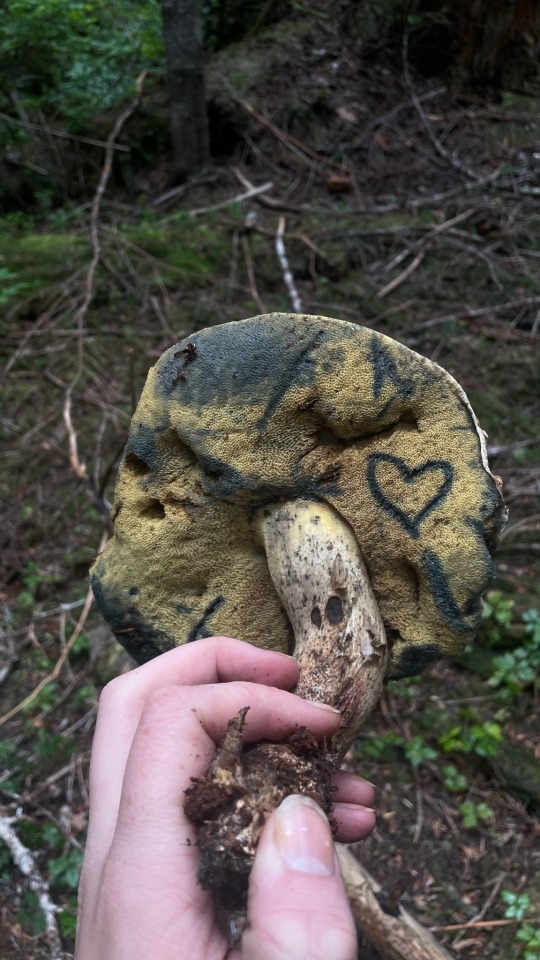

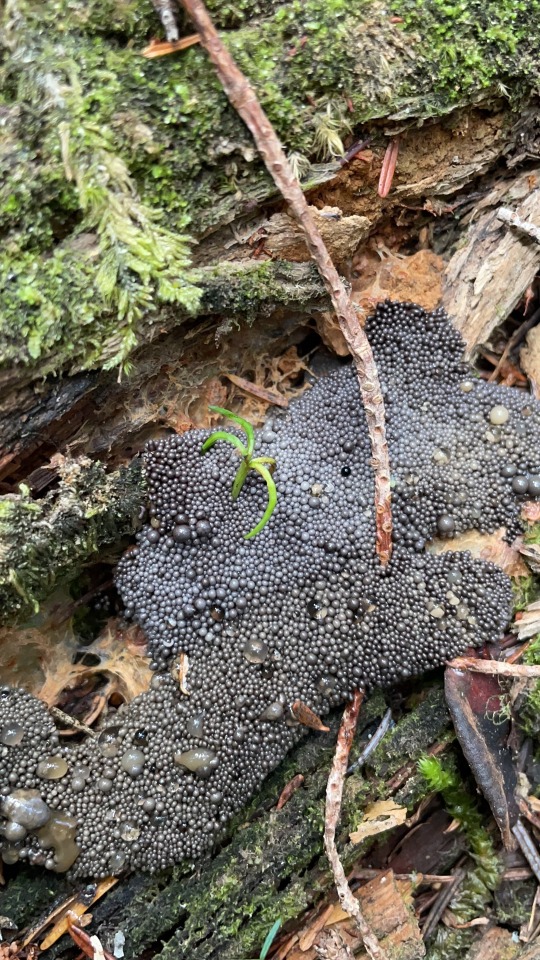

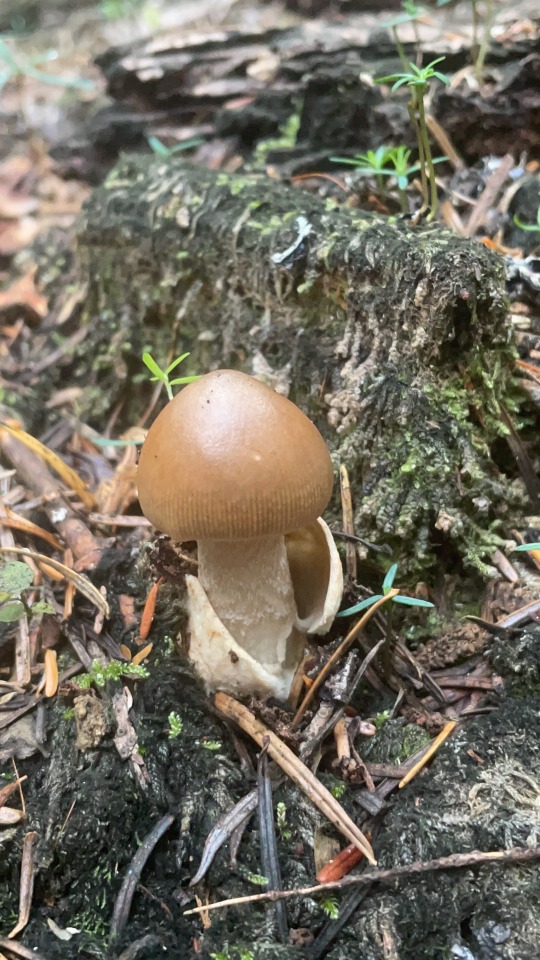
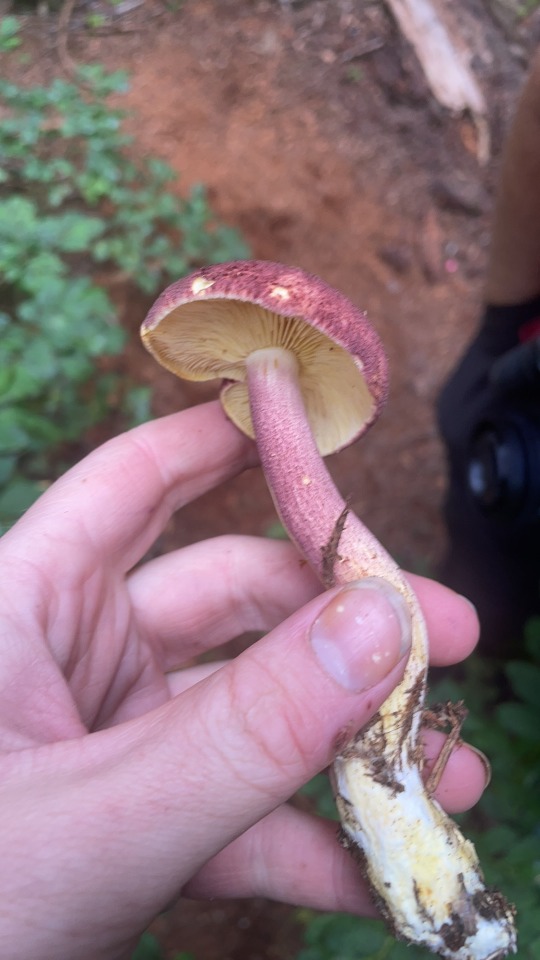


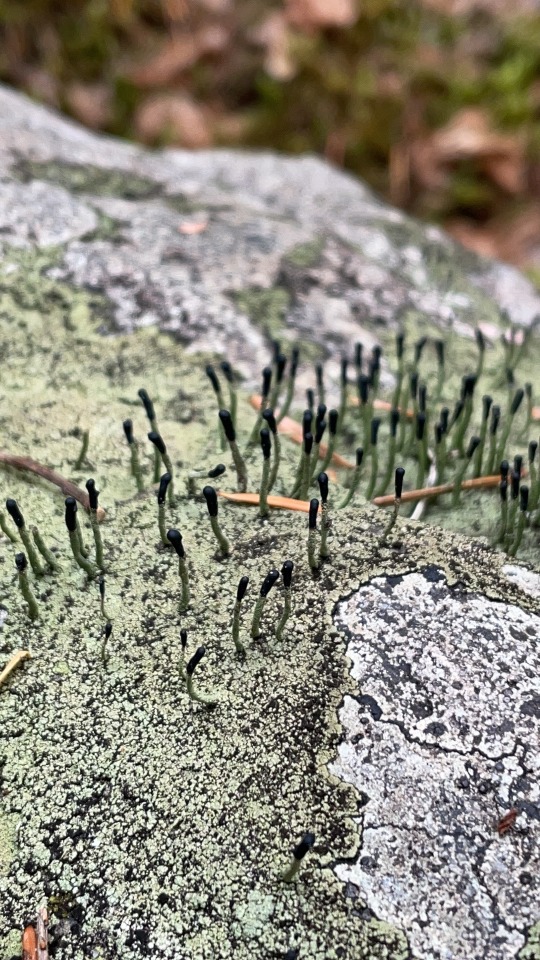

Some photos from yesterday: blue staining bitter bolete (I’ve never seen a mushroom stain that fast!), a giant rock I brought home because it has tapered matchstick lichen on it (former logging area not a national park), slime mold of unknown species, salmon eggs slime mold, western grissette emerging from its egg (possibly, either way I never fuck with amanitas because of how many deadly ones there are and the difficulty IDing them), plums and custard, golden collybia, some white bolete that stained blue, tapered match stick lichen, and a very orange eyelash cup. There were toooons of them but this one was so vibrant
85 notes
·
View notes